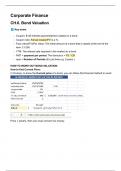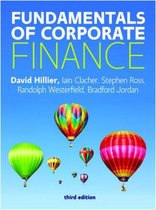Corporate Finance
CH.6. Bond Valuation
➡️ Key terms
Coupon: $120 interest payment(dinero) stated on a bond.
Coupon rate: Annual coupon/FV is a %.
Face value(FV)/Par Value: The initial amount of a bond that is repaid at the end of the
term. £1,000.
YTM: The interest rate required in the market on a bond
PMT = payment per period. The formula is = FV * CR
nper = Number of Periods (it's just time e.g. 9 years ).
HOW TO WORK OUT BOND VALUATION:
How to find Current Price:
In Finance, to know the Current price of a bond, you can follow this financial method in excel:
Price = price%, then you must convert it to money.
,How to find YTM:
How to find CR:
‼️How to find YTM with many unknowns:
Given Information:
Coupon Rate = 7.5% annually
Par Value = 100% (Assumed to be $1,000 for simplicity)
Current Price = 105% of Par = 105% * $1,000 = $1,050
Time Remaining to Maturity = 8 years (since the bond was issued 2 years ago for a 10-
year term)
Coupon Payment Frequency = Semi-Annual (2 times per year)
Step-by-Step Solution:
1. Calculate the Semi-Annual Coupon Payment:
The bond pays 7.5% annually in coupon payments, which means the semi-annual coupon
payment is:
Semi-Annual Coupon Payment=(Coupon Rate × Par Value)/2=(7.5%×1,000)/2=$37.50
2. Enter the Known Values in Excel:
N (Total number of periods) = 8 years×2=16 semi-annual periods8 \text{ years} \times
2 = 16 \text{ semi-annual periods}8 years×2=16 semi-annual periods
PMT (Coupon payment) = $37.50
PV (Present value or current price of bond) = $1,050 (input as negative in Excel for
present value)
, FV (Future value or par value at maturity) = $1,000
Rate (YTM) = This is the unknown value we will calculate using Excel.
3. Use the Excel RATE Function:
The formula to calculate the YTM in Excel is:
=RATE(N, PMT, -PV, FV)
N = 16 (semi-annual periods)
PMT = 37.50
PV = -1,050 (negative because it's the purchase price)
FV = 1,000
👀When you input this formula into Excel, you will get the semi-annual yield.
Multiplying by 2 will give the annual YTM.
=RATE(16, 37.50, -1050, 1000) * 2
Interest Rate Risk.
(exercise 18. also, page 271)
The risk that arises for bond owners from fluctuating interest rates is called interest rate risk.
How much interest rate risk a bond has depends on how sensitive its price is to interest rate
changes.
This sensitivity depends directly on two things: the time to maturity and the coupon rate.
1. All other things being equal, the longer the time to maturity, the greater the interest
rate risk.
2. All other things being equal, the lower the coupon rate, the greater the interest rate
risk.






